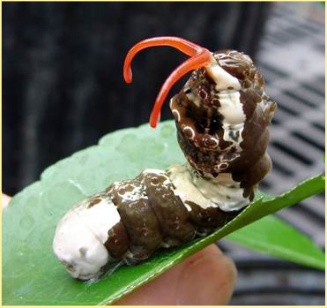This week has been a busy one for home gardeners in Colquitt County. Let’s talk about some of the questions I have been receiving, and hopefully this can help you.
What are those big worms on my citrus tree? This has been a topic of discussion for a week or so among home citrus enthusiasts. These worms are probably the orange dog caterpillar, which is the larva of the giant swallowtail butterfly. The butterfly lays eggs that hatch on new growth flushes. The larvae consume the young foliage. The eggs are easy to see when looking at the young foliage. The butterfly is large and black and yellow. Treatment is seldom required on larger trees, but they can defoliate young trees. If you would like to treat, please consider a BT insecticide product.

How do I control citrus leaf miners? I am glad you asked about this. Consider drenching young trees with imidacloprid before the new growth flushes in early May. This control measure may last up to two months of citrus leaf miner control or spray new growth mid-flush for up to two weeks of control. Leaf miners should be controlled on young trees as they will slow growth. Please read insecticide labels before application. Trees with a heavy fruit load may not require a treatment as they usually have a small flush. The first flush in March is not usually significantly attacked in Georgia, and treatment is normally not needed.
When do I fertilize my citrus tree? I would consider using 10-10-10 fertilizer (or an equivalent) for the bearing tree. Three applications per year—February, May–June, and August–September are suggested. Apply fertilizer from near the trunk to well beyond the leaf drip of the tree (on large trees, this usually involves fertilizing about 4 to 6 feet beyond the leaf drip). A reasonable rate of application to maintain healthy foliage and good fruiting is about half a pound of 10-10-10 fertilizer per year of the tree’s age (rates are for sandy soils; clay soils and others with greater inherent fertility would require less fertilizer). After a number of years, a fertilizer containing nitrogen and potassium or just nitrogen alone may prove adequate. A maximum of 1.5 to 3.0 pounds of actual nitrogen per tree per year should be adequate.
If you have questions please contact your local county agent.